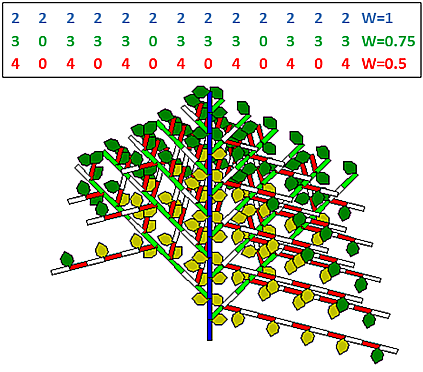GreenLab Course
Development
Structure construction basis
The phytomer builds the elementary unit that the structure is built with.
We have however seen that organogenesis and stochastic modelling apply to a given number of growth cycles, thus considering the axis level.
Axis of Development notion
-
In structural and functional structural plant models, plant structure
construction is performed individually, plant by plant.
In the GreenLab model, since an explicit structure is not required to simulate plant development and growth (only the number of organs per cohort needs to be known), structure construction is only partially done.
More precisely, only simple sequences of structure are computed and stored, one for each physiological age.
In the case of stochastic simulations, a limited number of stochastic realisations are computed for each physiological age.
These sequences are in fact defined by the Bernoulli trials applied to each physiological age (and stochastic realization).
They define the plant's axis of development.
Axis of development
The axis of development Axdφ of physiological age φ defines the successive results of the Bernoulli trials applied to the terminal meristem of physiological age φ from the seed stage to plant age.
- Axdφ is thus a state list for instance {0,0,0,1,1,1,0,1,0,1,1....}
where
Axdφ(i) = "1" (a Bernoulli trial success) defines therefore a phytomer of physiological age φ, whose ontological age is i.
This phytomer is thus explicit, and it's properties are explicitly defined; in particular, its bearing organs, defined from the dual scale automaton.
An efficient way of encoding is to encode the physiological age of its axillary bud instead of "1" (see figure below).
Axdφ(i) = "0" (a Bernoulli trial failure) defines therefore a rest occurring at growth cycle i.
A simple example

An example of a continuous axis of development (Image P. de Reffye, CIRAD)
- This continuous growth example shows three physiological ages
Top, the 3 axes of development are shown on 13 growth cycles.
Physiological age 1 axis has a development ratio of 1, has no rest, and each phytomer bears a physiological age 2 axis.
Physiological age 2 axis has a development ratio of 0.75, has no rest, and each phytomer bears a physiological age 3 axis.
Physiological age 3 Axis has a development ratio of 1, has no rest, and each phytomer bears a physiological age 4 axis, but does not branch.
The corresponding reconstructed structure is shown below. Internodes in grey are virtual ones and indicates rests.
Another example with rhythmic growth

An example of a crhythmic axis of development (Image P. de Reffye, CIRAD)
- This rhyhtmic growth example shows four physiological ages
The 4 axes of development are shown on 20 growth cycles.
All axes show acrotony
Rest periods on rhythms of the 4 physiological ages are not synchronized.
The corresponding reconstructed structure is shown below. Internodes in grey are virtual ones and indicates rests.
